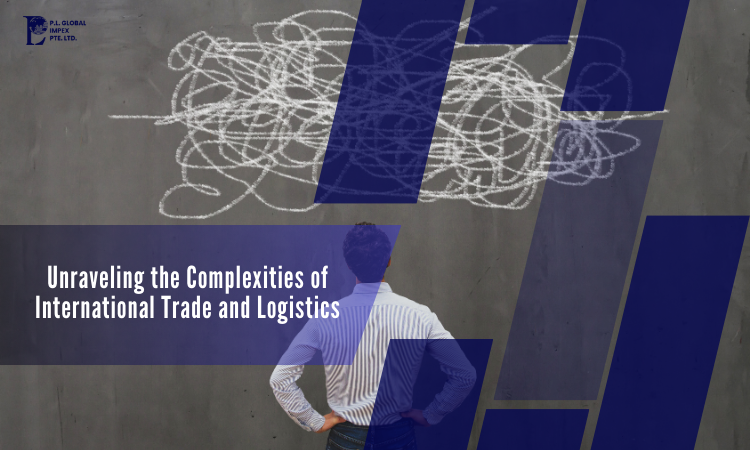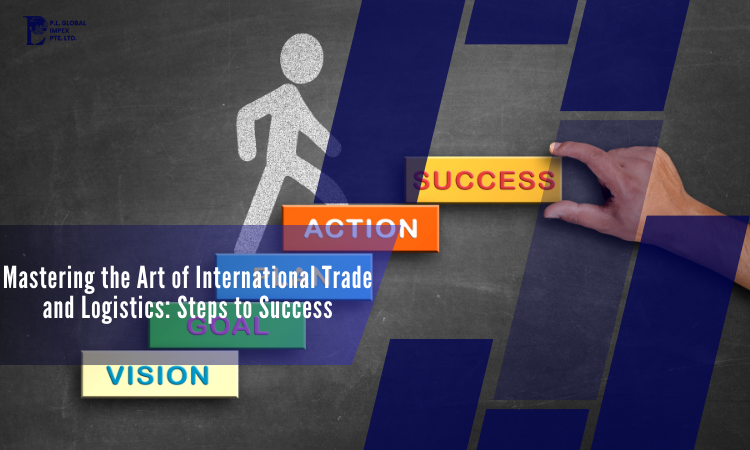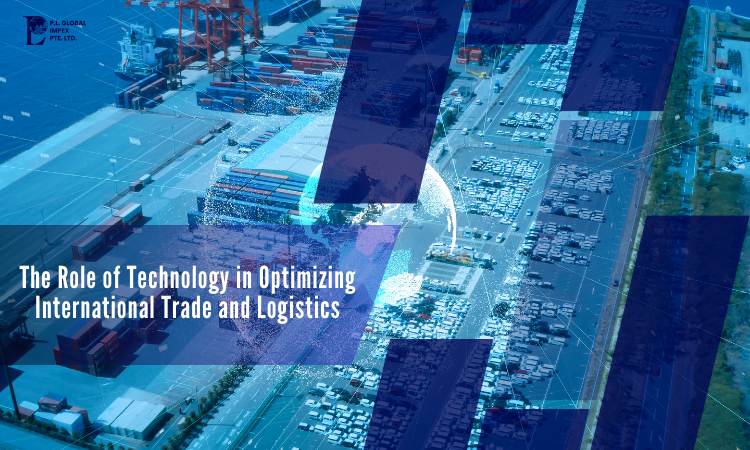Introduction:
The Ultimate Resource for Excelling in International Trade and Logistics. Are you eager to unlock the secrets to a successful career in trade and logistics? Look no further! This comprehensive guide will equip you with the knowledge and expertise needed to master the intricacies of global commerce. Whether you’re pursuing a Master’s in international trade and logistics or simply seeking to enhance your understanding, we’ve got you covered. Join us as we delve into the world of trade and logistics, exploring the ins and outs of foreign trade logistics and international commerce. Get ready to embark on a journey towards professional excellence.

1. Unraveling the Complexities of International Trade and Logistics
International trade and logistics have become crucial pillars of the global economy, shaping the way countries and businesses engage with one another on a global scale. In today’s interconnected world, the complexities surrounding trade and logistics have increased significantly, requiring a deep understanding and strategic approach to navigate the challenges and maximize opportunities.
A comprehensive understanding of international trade and logistics is essential for professionals looking to excel in this field. Pursuing a Master’s in International Trade and Logistics can provide individuals with the knowledge, skills, and expertise necessary to unravel the complexities of this ever-evolving landscape.
The Master’s in International Trade and Logistics program delves into various facets of trade and logistics, providing students with insights into supply chain management, transportation, customs regulations, import-export processes, and risk management. By examining the interdependencies between various elements of the trade cycle, students develop a holistic perspective on the challenges and opportunities inherent in international trade and logistics.
The program also explores emerging trends and practices in the field, incorporating topics such as e-commerce, sustainability, and digitalization, which have revolutionized the traditional trade and logistics landscape. This forward-thinking approach equips students with the necessary tools to adapt and succeed in an increasingly globalized marketplace.
Moreover, the Master’s program offers a unique blend of theoretical knowledge and practical application, providing-on experience through real-world case studies, internships, and industry collaborations This experiential approach not only enhances’ understanding but alsoips them with the-solving and strategic thinking demanded in today’s competitive global business environment.

2. The Impact of Globalization on International Trade and Logistics
- Global Supply Chains and Trade Networks:
Globalization has facilitated the establishment of complex and extended supply chains, enabling businesses to source materials, manufacture products, and distribute them across continents. This integration of international trade networks has resulted in increased efficiency and specialization, allowing companies to access global markets and take advantage of comparative advantages.
- Evolving Consumer Behavior:
As globalization has opened up new markets, consumer preferences and behavior have also evolved. Today’s consumers have access to a wide range of products and services from all around the world, leading to increased demand for imported goods. This shift in consumer behavior has compelled companies to adapt their supply chain and logistics strategies, ensuring timely and cost-effective delivery of products to meet customer expectations.
- Technological Advancements:
The advancements in technology have played a crucial role in transforming the landscape of international trade and logistics. From automated inventory management systems to sophisticated tracking and tracing tools, logistics operations have become more streamlined and transparent. On the trade front, digitization has paved the way for e-commerce platforms, enabling businesses of all sizes to engage in cross-border trade effortlessly.
- Regulatory Frameworks and Trade Agreements:
Globalization has led to the establishment of various trade agreements and regulatory frameworks aimed at facilitating international trade. These agreements, such as free trade agreements and regional trade blocs, have reduced trade barriers and promote economic cooperation between countries. However, complying with diverse regulations and customs requirements can pose challenges for logistics providers, necessitating efficient trade facilitation mechanisms.

3. Navigating the World of Foreign Trade Logistics: A Comprehensive Guide
Understanding the Basics of International Trade and Logistics
In today’s globalized economy, international trade plays a crucial role in driving economic growth and prosperity for nations around the world. However, the process of facilitating trade across borders involves a complex web of logistics and regulations that can be overwhelming for businesses venturing into foreign markets. This comprehensive guide aims to demystify the world of foreign trade logistics, equipping you with the knowledge and understanding necessary to navigate this intricate landscape with ease.
Master’s in International Trade and Logistics: A Pathway to Expertise
For individuals aspiring to become experts in the field of international trade and logistics, pursuing a Master’s degree can provide valuable insights and specialized knowledge. A Master’s in International Trade and Logistics program incorporates multidisciplinary coursework, covering topics such as trade policies, transportation, supply chain management, customs regulations, and global trade agreements. This advanced level of education prepares individuals to handle the complexities of global trade while developing critical thinking, problem-solving, and decision-making skills.
Unraveling the Dynamics of Foreign Trade Logistics
Foreign trade logistics refers to the management and coordination of activities involved in the movement of goods and services across international borders. It encompasses various processes, including transportation, warehousing, customs clearance, documentation, and risk management. Understanding these dynamics is essential to ensure the seamless flow of goods between countries, optimize supply chain efficiency, and mitigate potential risks. By familiarizing yourself with key concepts and industry best practices, you can effectively plan, execute, and monitor your international trade operations, leading to enhanced productivity and profitability.
The Importance of Effective Supply Chain Management
In the world of foreign trade logistics, effective supply chain management is paramount. A well-optimized supply chain ensures timely delivery of goods, minimizes costs, maximizes customer satisfaction, and improves overall business performance. This involves harmonizing different activities, including sourcing, production, inventory management, transportation, and information sharing. By adopting advanced supply chain management strategies and leveraging technological advancements like automation and data analytics, businesses can gain a competitive edge in the international market.

4. Mastering the Art of International Trade and Logistics: Steps to Success
In today’s interconnected world, mastering the art of international trade and logistics is more important than ever before. With opportunities for businesses to expand globally and tap into new markets, having a deep understanding of the processes and strategies involved is essential for success. Whether you are a professional already working in the field or someone looking to build a career in international trade and logistics, here are some steps to help you navigate and excel in this dynamic industry.
- Acquire the Right Knowledge and Skills: To begin your journey towards mastering international trade and logistics, gaining a solid educational foundation is crucial. Pursuing a Master’s in International Trade and Logistics can provide you with a comprehensive understanding of the industry’s complexities, including topics such as supply chain management, export-import procedures, trade regulations, and global logistics strategies.
- Stay Updated with Industry Trends: International trade and logistics are constantly evolving, driven by factors such as technological advancements, geopolitical changes, and shifts in consumer demand. To stay ahead of the curve, it is essential to stay updated with the latest trends and developments. Engage in continuous learning by attending industry conferences, participating in training programs, and subscribing to relevant publications and newsletters.
- Build a Strong Network: Networking plays a significant role in the success of any profession, and international trade and logistics are no exception. Often, job opportunities and valuable insights come through personal connections. Attend trade shows, join professional organizations, and engage with industry experts on social media platforms to expand your network of contacts.
- Gain Practical Experience: Theory alone is not enough to master international trade and logistics. Practical experience is vital to truly understand the intricacies of the industry. Look for internships, apprenticeships, or entry-level positions in organizations engaged in foreign trade logistics. This hands-on experience will provide valuable insights into real-world challenges and help you develop problem-solving skills.
- Embrace Technology: Technology plays a pivotal role in modern-day trade and logistics. From automation and artificial intelligence to blockchain and data analytics, leveraging technology can streamline processes, improve transparency, and optimize supply chain operations. Stay updated with emerging technologies and be open to embracing their potential in your work.

5. The Role of Technology in Optimizing International Trade and Logistics
In today’s globally interconnected world, international trade and logistics play a vital role in driving economic growth and ensuring the smooth flow of goods and services across borders. The success of businesses engaging in foreign trade logistics heavily relies on efficient systems and processes. Thankfully, technology has emerged as a game-changer, revolutionizing the way international trade and logistics are managed and optimized.
One key aspect where technology has made a significant impact is in supply chain management. With advanced tracking and tracing systems, businesses can now have real-time visibility into their shipments, reducing the risk of delays or lost goods. Furthermore, modern technology enables the automation of various logistical processes, such as inventory management and order fulfillment, streamlining operations and improving overall efficiency.
Another area where technology has proven invaluable is in customs and compliance. With the rise of electronic documentation and automated customs clearance systems, the processing of trade-related documents has become faster and more accurate. This not only saves time for businesses but also reduces the potential for errors and associated penalties.
Moreover, technology has played a crucial role in enhancing communication and collaboration within the international trade and logistics ecosystem. Digital platforms and cloud-based software enable seamless information sharing between different stakeholders, including exporters, importers, freight forwarders, and government agencies. This level of interconnectedness fosters better coordination, leading to smoother trade flows and faster response times.
Additionally, the emergence of Artificial Intelligence (AI) and machine learning has further enhanced the optimization of international trade and logistics. These technologies can analyze vast amounts of data, predict demand patterns, optimize routing decisions, and even automate certain tasks, unlocking new levels of efficiency and cost-effectiveness.
6. Insider Tips for Effective Supply Chain Management in International Trade
In today’s globalized world, businesses are increasingly engaging in international trade to expand their customer base and tap into new markets. However, with the opportunities that come with international trade also come unique challenges, particularly when it comes to supply chain management. Effectively managing the movement of goods across borders and ensuring a seamless flow throughout the supply chain can be a complex endeavor. To help businesses navigate these challenges, we have compiled a list of insider tips for effective supply chain management in international trade.
- Develop Clear Communication Channels: Clear and open communication is paramount to successful supply chain management. Establish effective communication channels with all stakeholders, from suppliers to shipping partners, to ensure everyone is aligned on expectations and timelines.
- Stay Updated on Trade Regulations: International trade is heavily regulated, and compliance with trade regulations is crucial for avoiding delays and penalties. Keep abreast of changing regulations and ensure your supply chain processes are in line with the latest requirements.
- Build Trusting Partnerships: Collaborating with reliable partners is essential for effective supply chain management. Invest time and effort into building long-term relationships with trusted suppliers, distributors, and logistics providers who have a proven track record in international trade.
- Invest in Technology: Embrace technology solutions that can streamline your supply chain operations. From inventory management systems to blockchain-based solutions for traceability, leveraging technology can enhance visibility, efficiency, and accuracy in your supply chain.
- Conduct Risk Assessments: International trade inherently carries risks, such as geopolitical uncertainties, natural disasters, or supply chain disruptions. Regularly evaluate potential risks and develop contingency plans to mitigate their impact on your supply chain.
- Foster a Culture of Continuous Improvement: Encourage a mindset of continuous improvement among your supply chain team. Actively seek feedback, analyze performance metrics, and implement process enhancements to drive efficiency and keep up with evolving customer demands.
By implementing these insider tips, businesses can enhance their supply chain management practices and overcome the unique challenges of international trade. Effective supply chain management is not only key to meeting customer expectations but also contributes to maintaining a competitive edge in a global marketplace.

7. Understanding Tariffs and Trade Regulations: A Guide for International Logistics
An Overview of Tariffs:
In this section, we will discuss the basics of tariffs, including their definition, types, and the purpose behind their implementation. We will explore the difference between ad valorem and specific tariffs and provide examples to illustrate their impact on international trade. Understanding tariffs is crucial for logistics professionals, as they directly affect the cost and feasibility of transportation and distribution across borders.
Trade Regulations and Compliance:
In this section, we will explore the various trade regulations that govern international trade, such as import and export controls, customs procedures, and documentation requirements. We will discuss common challenges faced by logistics professionals, such as obtaining the necessary permits and licenses, ensuring compliance with sanitary and phytosanitary measures, and navigating through complex customs regulations.
The Role of Trade Agreements:
Trade agreements play a vital role in reducing barriers and enhancing the flow of goods and services between nations. In this section, we will explain the concept of trade agreements, including regional and bilateral trade agreements, and their impact on international logistics. We will also highlight key trade agreements, such as NAFTA, EU-Mercosur, and the Comprehensive and Progressive Agreement for Trans-Pacific Partnership (CPTPP), and discuss the benefits they offer to logistics professionals.
8. From Shipping to Warehousing: Key Elements of International Trade and Logistics
1. Understanding Trade and Logistics:
The first step towards mastering international trade and logistics is grasping their fundamental concepts. Trade involves the exchange of goods and services between countries, while logistics encompasses the planning, coordination, and execution of various activities involved in the movement and storage of these goods. This section will delve deeper into the different modes of transportation, such as shipping, air freight, and land transportation, highlighting their respective advantages and considerations.
2. Foreign Trade Logistics:
Moving goods across borders demands a comprehensive understanding of customs regulations, documentation requirements, and international trade agreements. Here, we will explore the key elements of foreign trade logistics, including customs compliance, import and export processes, and the role of intermediaries like customs brokers and freight forwarders. This section will provide insights into the necessary procedures and considerations companies must undertake while engaging in international trade.
3. The Role of Warehousing and Inventory Management:
Efficient warehousing and inventory management lie at the heart of successful international trade and logistics operations. This section will discuss the importance of strategic warehousing locations, inventory optimization techniques, and effective supply chain management practices. Additionally, modern advancements such as warehouse automation and the use of technology will be explored, showcasing how businesses can enhance their logistics capabilities.

9. Unpacking the Benefits of Pursuing a Master's in International Trade and Logistics
- Specialized Knowledge and Expertise: By enrolling in a Master’s program focused on international trade and logistics, you gain access to a curriculum designed specifically to equip you with a deep understanding of global trade dynamics, supply chain management, and transportation logistics. This specialized knowledge sets you apart from other professionals in the field, opening doors to a wide range of career opportunities.
- Enhanced Global Perspective: International trade is a complex and fast-paced landscape, constantly influenced by global trends and policies. A Master’s degree in this discipline allows you to develop a broader perspective on global markets, economies, and regulations. Armed with the ability to analyze trends and assess risks, you become a valuable asset for companies aiming to expand their international presence.
- 3. Networking Opportunities: Pursuing a Master’s degree often involves collaborating with classmates hailing from diverse professional backgrounds. This exposure to a multitude of perspectives allows you to broaden your professional network and establish connections that may prove instrumental in future business endeavors. Furthermore, universities offering such programs often have strong relationships with industry leaders, providing you with valuable networking opportunities and potential internships or job placements4. Career Advancement: The specialized skills knowledge acquired during a Master’s program can significantly your career prospects. Whether you aspire to work in global trade organizations, logistics companies, manufacturing firms, or bodies, a Master’s in International Trade and can position you as ideal candidate for leadership roles in these industries. Additionally, this degree may also open doors to consultancy and research positions in academia or think tanks.
10. Strategies for Overcoming Challenges in International Trade and Logistics
1. Building Strong Relationships:
Establishing and maintaining solid relationships with key stakeholders is crucial in international trade and logistics. This includes suppliers, partners, customers, and government authorities. Regular communication, trust, and mutual understanding can help overcome challenges caused by cultural differences, language barriers, and conflicting business practices.
2. Implementing Risk Management Techniques:
Identifying and assessing potential risks is essential to minimize their impact on trade and logistics operations. This involves conducting thorough risk assessments, developing contingency plans, and implementing risk management techniques. For example, diversifying suppliers and transportation routes can help mitigate the risk of disruptions caused by political instability or natural disasters.
3. Staying Updated on Trade Policies and Regulations:
International trade is heavily regulated, and staying updated on the latest policies and regulations is crucial for compliance and risk mitigation. Building a team of experts or partnering with a professional logistics provider can help navigate through complex trade regulations and ensure smooth customs clearance and documentation processes.
4. Investing in Technology and Automation:
Adopting technology and automation tools can significantly streamline trade and logistics operations. This includes implementing supply chain management systems, track-and-trace technologies, and automated inventory management solutions. These technologies can enhance transparency, efficiency, and accuracy, reducing the risk of errors and delays.
5. Continuous Monitoring and Performance Evaluation:
Regularly monitoring and evaluating the performance of trade and logistics processes is essential for identifying areas of improvement and addressing potential risks. Key performance indicators, such as on-time delivery, cost-effectiveness, and customer satisfaction, can help measure the success of strategies implemented and allow for adjustments accordingly.
Conclusion:
Mastering international trade and logistics is crucial for success in today’s global marketplace. With the right education, such as a Master’s in international trade and logistics, professionals can gain the knowledge and skills needed to excel in this complex field. Whether it’s understanding foreign trade logistics or navigating the intricacies of international trade, this guide has provided a comprehensive overview to help you succeed in this dynamic industry.
